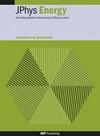具有一阶相变的BaTiO3多层电容器的电热效应
IF 6.3
3区 材料科学
Q1 ENERGY & FUELS
引用次数: 3
摘要
电热(EC)材料在电场的作用(或去除)下表现出较大的绝热温度变化或等温熵变,为取代传统蒸汽压缩系统中使用的有害气体提供了热量热泵的有效替代方案。最近,由于Pb(Sc0.5Ta0.5)O3多层陶瓷电容器(Nair等人2019 Nature 575 468)具有强烈的一阶相变,并且在基于这些电容器的原型中报道了13 K的温度跨度(Torelló等人2020 Science 370 125),因此报道了5.5 K的大EC温度变化。然而,铅的毒性迫使研究人员寻找具有竞争性EC性能的环保材料。在此,我们利用红外摄像机研究了无铅BaTiO3多层电容器中的EC效应。与商用BaTiO3电容器不同,我们制备的样品没有牺牲BaTiO3中的一阶相变,同时添加少量的0.2 mol% Mn作为受体掺杂剂以提高电阻率。用差示扫描量热法观察到,它们的EC绝热温度随温度变化呈两个峰,与BaTiO3的两个一级相变相匹配。在170 kV cm - 1下,在70 K的温度范围内测量到温度下降约0.9 K,从30°C开始,接近四方向正交相变。在相同的电场作用下,在126℃时,在BaTiO3的居里温度下,记录到的最大温度变化为2.4 K。我们的研究结果表明,进一步优化的BaTiO3电容器可以为设计无铅热冷却原型提供一条途径。本文章由计算机程序翻译,如有差异,请以英文原文为准。
Electrocaloric effect in BaTiO3 multilayer capacitors with first-order phase transitions
Electrocaloric (EC) materials, presenting large adiabatic temperature change or isothermal entropy change under the application (or removal) of electric fields, offer an efficient alternative to caloric heat pumps for replacing hazardous gases used in traditional vapor-compression systems. Recently, a large EC temperature change of 5.5 K have been reported in Pb(Sc0.5Ta0.5)O3 multilayer ceramic capacitors (Nair et al 2019 Nature 575 468) thanks to its strong first-order phase transition and a temperature span of 13 K has been reported in a prototype based on these capacitors (Torelló et al 2020 Science 370 125). However, the toxicity of lead forces researchers to find eco-friendly materials exhibiting competitive EC performances. Here, we study the EC effect in lead-free BaTiO3 multilayer capacitors using an infrared camera. Unlike commercial BaTiO3 capacitors, we prepared our samples without sacrifying the first-order phase transition in BaTiO3 while a low amount of 0.2 mol% Mn was added as an acceptor dopant to improve electrical resistivity. Their EC adiabatic temperature variations show two peaks versus temperature, which match BaTiO3 two first-order phase transitions, as observed by differential scanning calorimetry. We measured a temperature drop of ∼0.9 K over a temperature range of 70 K under 170 kV cm−1, starting at 30 °C near the tetragonal-to-orthorhombic phase transition. Under the same electric field, a maximum temperature change of 2.4 K was recorded at 126 °C, at BaTiO3’s Curie temperature. Our findings suggest that further optimized BaTiO3 capacitors could offer a path for designing lead-free caloric cooling prototypes.
求助全文
通过发布文献求助,成功后即可免费获取论文全文。
去求助
来源期刊

Journal of Physics-Energy
Multiple-
CiteScore
10.90
自引率
1.40%
发文量
58
期刊介绍:
The Journal of Physics-Energy is an interdisciplinary and fully open-access publication dedicated to setting the agenda for the identification and dissemination of the most exciting and significant advancements in all realms of energy-related research. Committed to the principles of open science, JPhys Energy is designed to maximize the exchange of knowledge between both established and emerging communities, thereby fostering a collaborative and inclusive environment for the advancement of energy research.
 求助内容:
求助内容: 应助结果提醒方式:
应助结果提醒方式:


